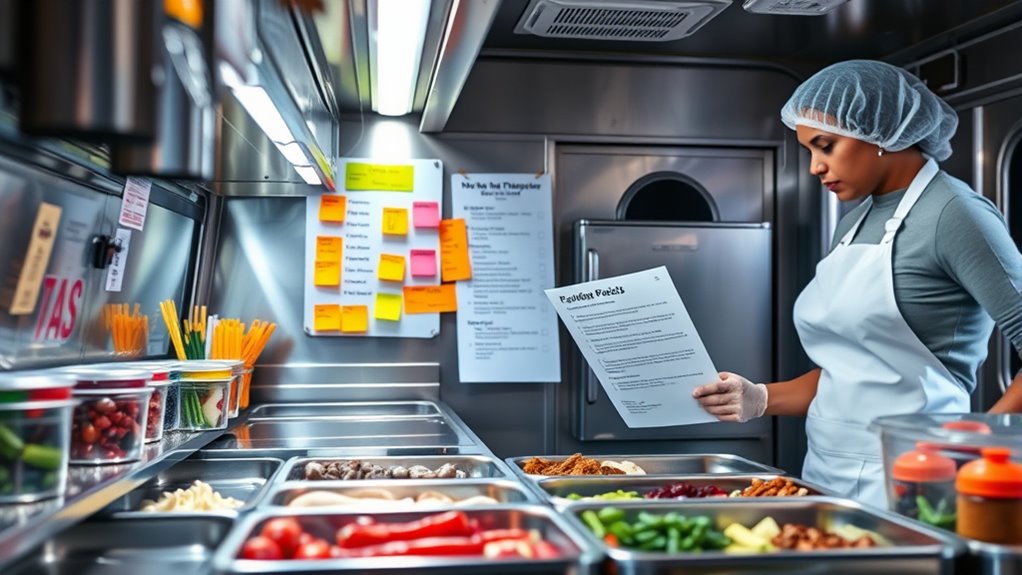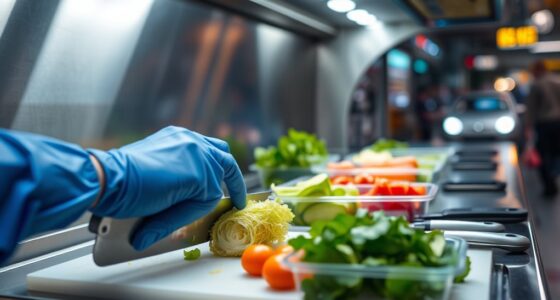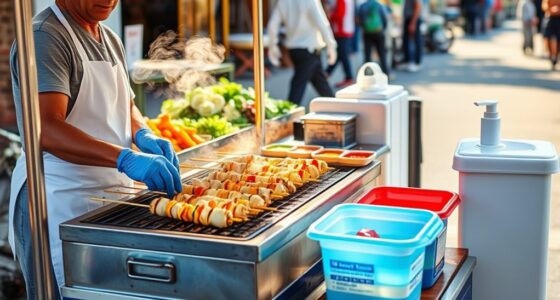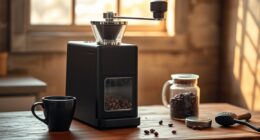To develop a food safety plan for mobile food units, start by evaluating risks like temperature control, cross-contamination, and limited space. Design your kitchen for hygiene and efficiency, ensuring easy-to-clean surfaces and proper storage. Train staff on proper handling and sanitation, and keep detailed records of maintenance, temperature checks, and cleaning schedules. Preparing for inspections and continuous updates helps maintain safety standards. If you keep going, you’ll discover detailed steps to keep your mobile operation safe and compliant.
Key Takeaways
- Conduct a comprehensive hazard analysis, identifying risks specific to mobile environments like temperature fluctuations and contamination sources.
- Establish strict procedures for food handling, storage, and temperature control tailored to limited space and mobile logistics.
- Develop sanitation protocols emphasizing surface cleanliness, pest prevention, and routine cleaning schedules for all equipment and surfaces.
- Implement staff training programs on food safety practices, certifications, and proper hygiene to ensure consistent compliance.
- Maintain detailed documentation of inspections, maintenance, temperature logs, and staff training for regulatory review and continuous improvement.
Assessing Food Safety Risks for Mobile Operations

When operating a mobile food unit, recognizing potential food safety risks specific to your mobile environment is vital. Your food vendor licensing requirements often include specific safety standards you must follow, so understanding these is the first step. Menu customization also impacts risk levels; offering perishable ingredients or complex dishes can increase contamination chances. You need to assess how your setup handles temperature control, storage, and cross-contamination risks. Mobile environments pose unique challenges like limited space and fluctuating temperatures, which can lead to unsafe food handling if overlooked. By identifying these risks early, you can implement targeted controls. Incorporating remote collaboration tools can enhance team training and safety protocol updates across multiple locations. Regularly reviewing your licensing conditions and adjusting your menu to minimize hazards will help guarantee food safety and regulatory compliance in your mobile operation. Additionally, understanding the food safety risks associated with mobile units allows for proactive measures to prevent foodborne illnesses. Recognizing temperature control challenges specific to mobile settings further supports maintaining safe food quality under varying conditions. Being aware of food handling practices is also crucial to prevent cross-contamination and ensure proper hygiene standards. Moreover, staying informed about regulatory updates ensures ongoing compliance with safety standards as guidelines evolve.
Designing a Clean and Sanitary Mobile Kitchen
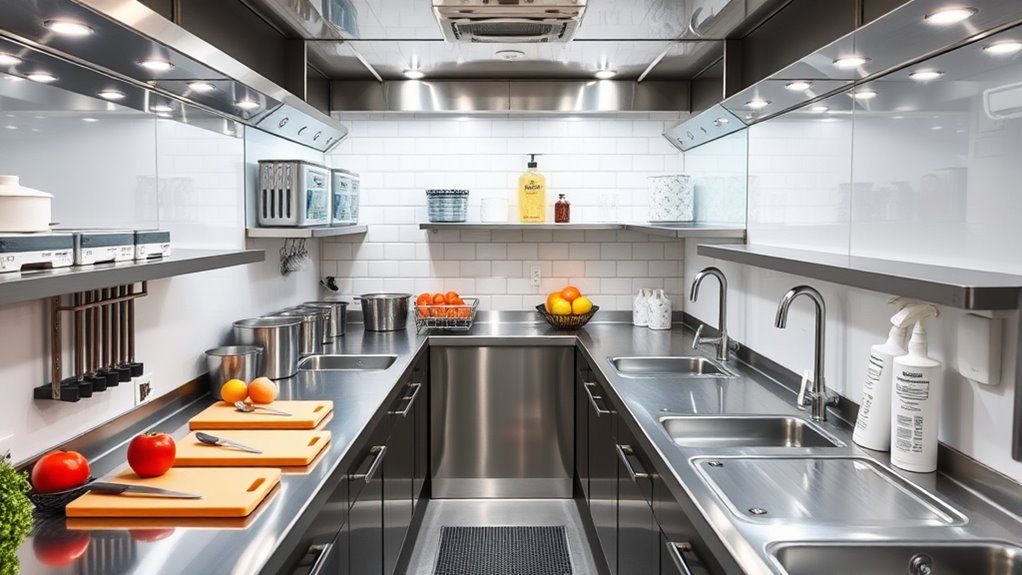
Creating a clean and sanitary mobile kitchen starts with following key design principles that promote hygiene and efficiency. Regular equipment maintenance is essential to safeguard against contamination and ensure safety. By focusing on these points, you can build a kitchen that supports safe food handling at all times. Incorporating hygienic design principles can further enhance sanitation and reduce risks of contamination. Additionally, implementing practical support measures, such as staff training and proper cleaning protocols, can help maintain a consistently sanitary environment. Using specialized cleaning tools designed for mobile kitchens can also improve sanitation efforts and streamline maintenance routines. Emphasizing continuous improvement ensures that sanitation standards evolve with changing needs and technologies. Moreover, understanding emotional support can help staff cope with the stresses associated with maintaining high hygiene standards.
Sanitary Design Principles
Designing a mobile kitchen with sanitary principles in mind guarantees food remains safe and uncontaminated throughout operation. To achieve this, prioritize smooth, non-porous surfaces that are easy to clean and resist bacteria buildup. Incorporate innovative packaging solutions to protect food from contamination during handling and storage. Proper layout design minimizes cross-contact between raw and cooked foods, reducing risks. Pest prevention is essential; seal all entry points and eliminate food debris promptly to deter pests. Adequate drainage and proper waste disposal also support cleanliness. Utilizing testing methodologies to routinely assess sanitation practices can further enhance safety. Implementing cleaning protocols ensures consistent hygiene standards are maintained across all areas. Additionally, adhering to retail hours can help schedule cleaning routines during off-peak times to maintain sanitation standards efficiently. Regular staff training on hygienic practices reinforces the importance of maintaining a clean environment. Incorporating sanitary design principles during setup can significantly reduce the potential for microbial growth and cross-contamination. By integrating these principles, you create a hygienic environment that not only safeguards food safety but also simplifies daily cleaning routines, ensuring compliance with health standards and maintaining customer trust.
Equipment Maintenance Strategies
Regularly maintaining your mobile kitchen equipment is vital to make sure it stays clean, sanitary, and functioning properly. Following maintenance schedules helps prevent breakdowns and ensures food safety. Proper equipment calibration ensures temperature controls are accurate, reducing the risk of contamination. Keep a detailed log of maintenance activities to track performance and identify issues early. Regularly inspecting equipment for wear or damage is essential, and cleaning should be done after each use. Some key strategies include:
- Adhering to a strict maintenance schedule
- Calibrating thermometers and temperature controls regularly
- Cleaning and sanitizing all surfaces and tools
- Checking for signs of damage or corrosion
- Documenting maintenance and calibration activities
- Incorporating sound healing science principles can support staff well-being and focus during maintenance routines. Routine inspections help catch potential issues before they escalate, ensuring continuous safe operation. Additionally, staying informed about food safety regulations ensures ongoing compliance and safety standards. Conducting periodic equipment performance assessments can further enhance operational reliability and safety. Implementing a comprehensive preventive maintenance plan can significantly reduce the likelihood of unexpected equipment failures. These practices promote a safe, efficient, and compliant mobile kitchen.
Establishing Proper Food Handling and Storage Procedures
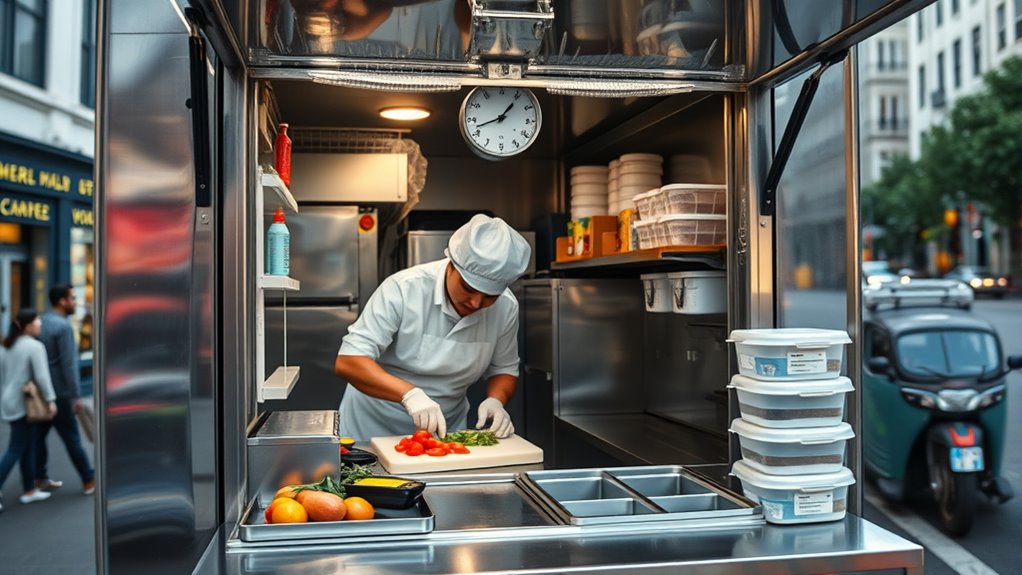
To guarantee food safety in your mobile food unit, you must establish clear procedures for handling and storing food properly. Start by developing strict food handling protocols that ensure cleanliness, prevent cross-contamination, and minimize risks. Always wash your hands thoroughly before handling food, and use gloves or tools when necessary. Follow storage guidelines by keeping raw and cooked foods separate, and store perishable items at proper temperatures in sealed containers. Label all items with preparation or expiration dates to monitor freshness. Regularly inspect storage areas for cleanliness and signs of spoilage. Proper handling and storage not only protect your customers but also help maintain food quality. Implementing temperature control measures is essential for preventing bacterial growth and ensuring food safety. Maintaining proper sanitation practices is crucial to prevent illness and comply with health regulations. Consistently applying these protocols and monitoring food safety practices keeps your food safe and your operation compliant. Additionally, staying informed about foodborne illnesses can help you recognize potential hazards early and take preventive action.
Implementing Temperature Control Measures
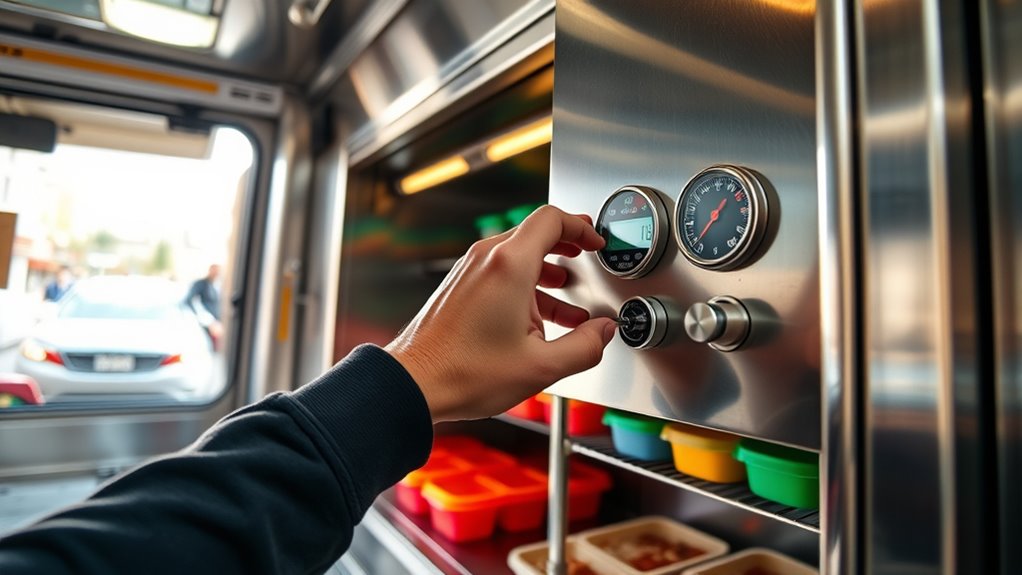
Maintaining proper temperature control is crucial to prevent bacterial growth and guarantee food safety in your mobile food unit. Consistent temperature monitoring ensures foods stay within safe ranges, reducing contamination risk. Use calibrated thermometers to check temperatures regularly. Cold storage must keep perishable items at or below 41°F (5°C). Avoid overcrowding refrigeration units to promote proper air circulation. Keep hot foods above 135°F (57°C) during holding. Label and date all stored items to track freshness. Maintain a log of temperature checks to identify issues early. Always troubleshoot cold storage units if temperatures fluctuate. Implementing these measures helps prevent foodborne illnesses and keeps your customers safe. Proper temperature control is essential for the success of your mobile food operation.
Training Staff on Food Safety Practices
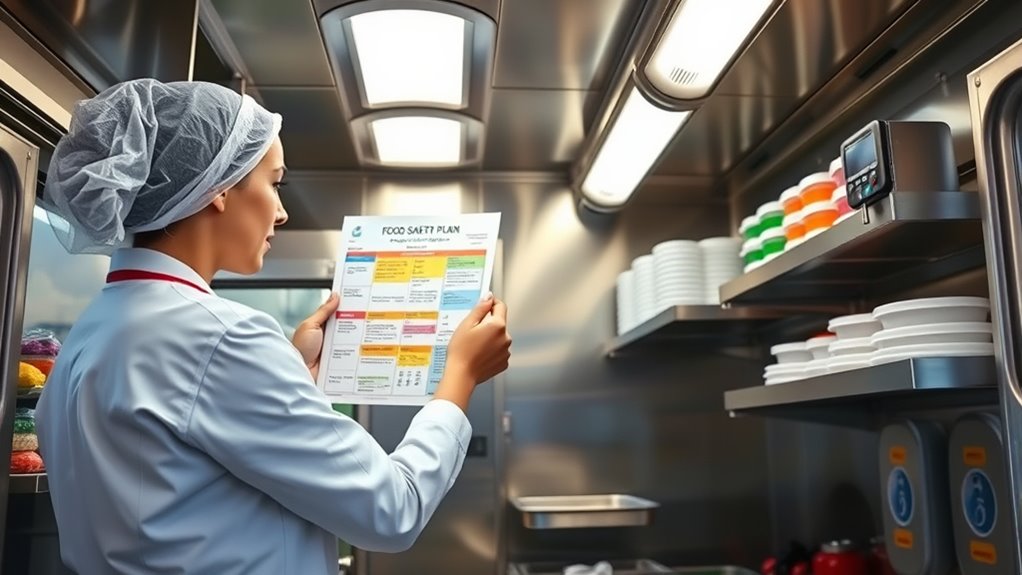
Training your staff on food safety practices is essential to guarantee that everyone understands their responsibilities and follows proper procedures. Implementing effective staff training programs ensures your team is knowledgeable about safe handling, hygiene, and sanitation protocols. Encouraging staff to obtain food safety certifications demonstrates their commitment and helps meet regulatory requirements. Regular training sessions keep employees updated on best practices and new food safety standards. Clear communication and hands-on instruction promote consistency across your mobile food unit operations. By prioritizing staff education, you reduce risks of contamination and foodborne illnesses. Well-trained staff not only protect your customers but also enhance your reputation. Investing in ongoing training ensures your team remains competent and confident in maintaining high food safety standards at all times.
Maintaining Documentation and Record-Keeping
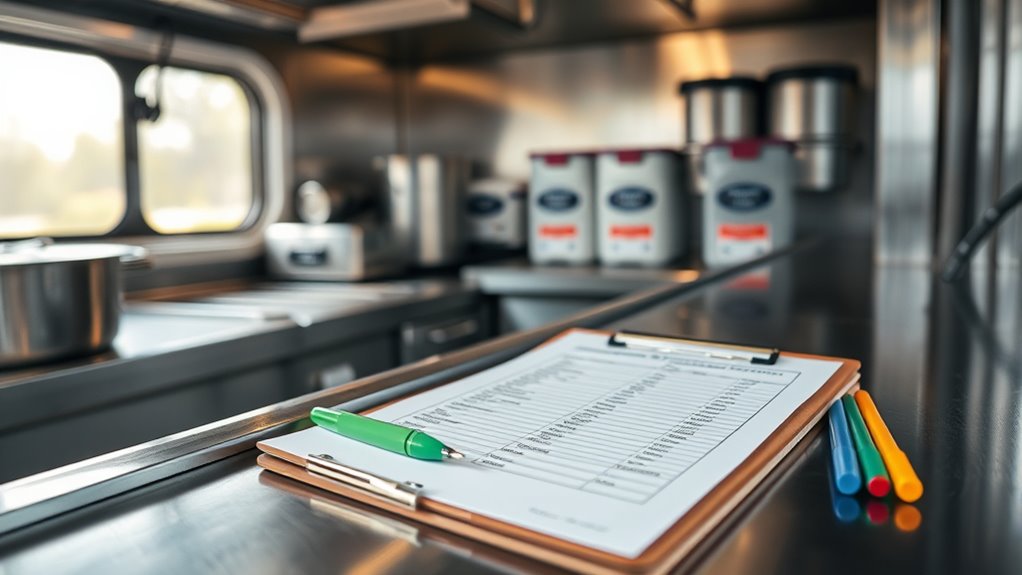
Keeping accurate records is essential for demonstrating compliance with food safety regulations and ensuring your mobile food unit runs smoothly. Proper documentation helps you track inventory, monitor staff training, and verify sanitation procedures. Consistent record-keeping reduces the risk of contamination and legal issues. To stay organized, maintain:
- Inventory tracking logs to monitor stock levels and expiration dates
- Staff training logs to document ongoing education and certifications
- Temperature logs for refrigeration and cooking equipment
- Cleaning schedules to verify sanitation routines
- Incident reports to record any food safety concerns or incidents
Preparing for Inspections and Continuous Improvement
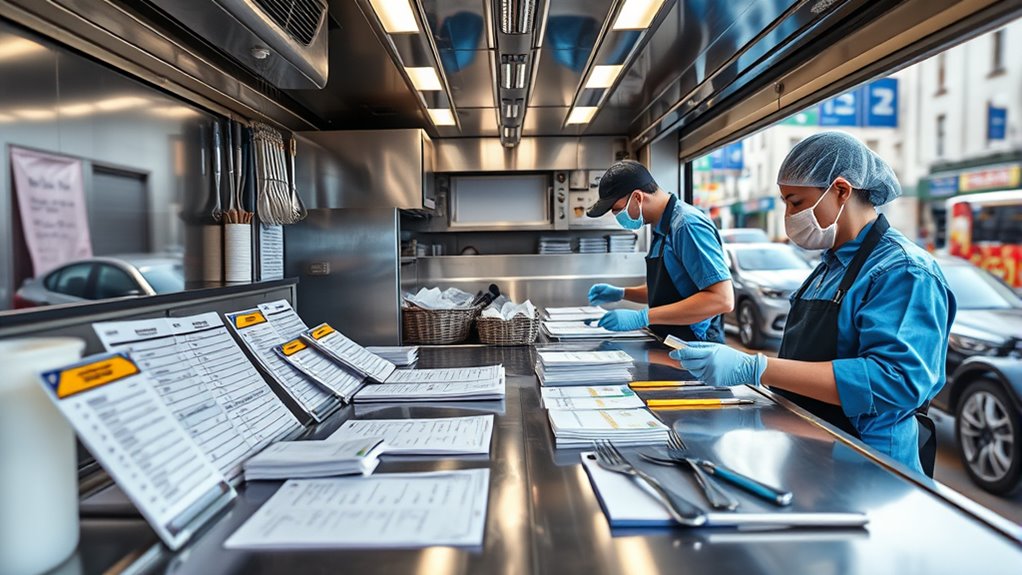
Being prepared for inspections is crucial to demonstrate your compliance with food safety standards and avoid potential violations. Regularly review your procedures, keep your documentation current, and train staff on safety protocols. Use customer feedback to identify areas for improvement and enhance your mobile marketing strategies to build trust. Stay organized with a checklist like this:
| Inspection Preparation | Continuous Improvement | Customer Feedback & Mobile Marketing |
|---|---|---|
| Keep records accessible | Regular staff training | Gather feedback via surveys |
| Maintain cleanliness | Review safety protocols | Use feedback for menu updates |
| Ensure equipment is functional | Conduct mock inspections | Promote safety measures online |
| Stay updated on regulations | Implement corrective actions | Engage customers through mobile |
This approach keeps your food safety plan proactive and responsive.
Frequently Asked Questions
How Often Should Mobile Units Review and Update Their Food Safety Plans?
You should schedule reviews of your food safety plan at least every six months, or more often if conditions change, such as new menu items or equipment updates. Regularly updating your plan guarantees it remains effective and current with safety standards. Keep track of any incidents or changes in regulations, and adjust the update frequency accordingly. Staying proactive helps prevent food safety issues and maintains compliance.
What Are Common Challenges Unique to Mobile Food Safety Compliance?
You face unique challenges in mobile food safety compliance, especially with mobile unit logistics and customer safety communication. Managing limited space and varying locations makes maintaining proper hygiene and temperature controls tough. Plus, you need to clearly communicate safety procedures to customers to prevent contamination. Staying adaptable, regularly training staff, and keeping safety info visible help you overcome these hurdles and guarantee your customers stay safe.
How Can Mobile Units Handle Food Recalls Efficiently on the Go?
When handling food recalls on the go, you should follow mobile recall procedures promptly and efficiently. Keep a list of all products and lot numbers, and have quick access to supplier contact info. Conduct on-the-go safety training regularly so staff knows their roles during recalls. This way, you can quickly identify affected items, remove them from service, and prevent contaminated food from reaching customers.
What Technology Tools Assist in Managing Food Safety Records?
Managing food safety records is easier with the right tech tools. Digital tracking lets you document temperature logs, cleaning schedules, and inspections instantly, keeping everything organized. Cloud storage guarantees your records are accessible anytime, anywhere, and protected from loss. While paper forms gather dust, these digital solutions streamline compliance, making it simple to monitor and respond swiftly to safety concerns. Embrace technology to keep your mobile food unit safe and efficient.
How Do Weather Conditions Impact Food Safety Protocols for Mobile Units?
Weather variability substantially impacts your food safety protocols for mobile units. Extreme temperatures, humidity, and sudden storms can compromise food quality and safety. You need climate adaptation strategies, like proper storage and temperature controls, to prevent spoilage and contamination. By staying alert to weather changes, you can adjust handling and sanitation practices accordingly, ensuring your food remains safe regardless of unpredictable weather conditions.
Conclusion
Think of your food safety plan as the GPS guiding your mobile unit through busy streets. Just like a reliable GPS prevents you from getting lost, thorough risk assessment and consistent practices keep your operation on track. When I started, a simple mistake almost cost me a health inspection. Now, with a solid plan, you’ll steer clear of pitfalls, ensuring safe, delicious food for every customer and a smooth ride to success.
